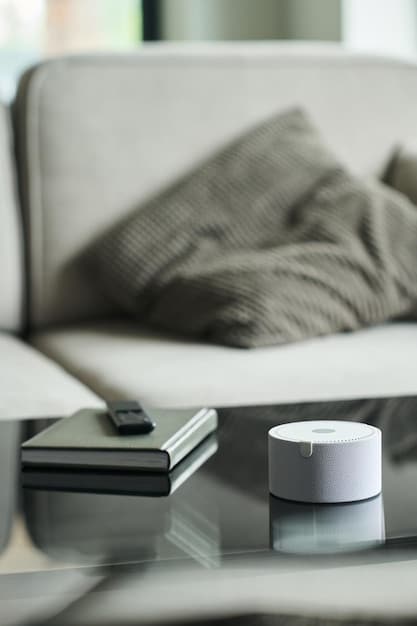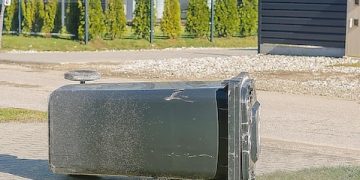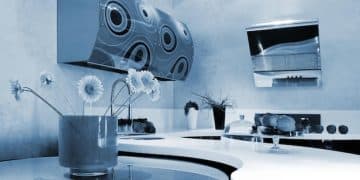Home Energy Audit: Save 20% on Heating Costs & Fix Leaks

A comprehensive home energy audit identifies hidden energy leaks and inefficiencies, offering a clear path to significantly reduce heating costs by up to 20% and enhance overall home comfort and sustainability.
Embarking on a home energy audit: identify and fix energy leaks to save up to 20% on heating costs isn’t merely about cutting down on utility bills; it’s a strategic investment in your home’s efficiency, comfort, and environmental footprint. This detailed process unveils hidden inefficiencies, from subtle drafts to inadequate insulation, transforming your residence into a more energy-conscious haven. Understanding where and how your home loses energy is the crucial first step towards significant savings and a more sustainable lifestyle.
Understanding the Basics: What is a Home Energy Audit?
A home energy audit is a comprehensive assessment of your home’s energy consumption. It pinpoints areas where energy is being wasted, whether through poor insulation, leaky windows, or inefficient appliances. This evaluation goes beyond just looking at your utility bills; it delves into the physical structure and operational aspects of your home, providing a holistic view of its energy performance.
The goal is not just to identify problems but to offer practical, actionable solutions tailored to your specific home. These solutions can range from simple DIY fixes to more significant investments in home improvements, all aimed at reducing your energy footprint and maximizing comfort.
The “Why”: Benefits Beyond Savings
While saving money is a primary motivator, the advantages of a home energy audit extend far beyond financial relief. A more energy-efficient home is often a more comfortable one, with consistent temperatures and fewer drafts. It also typically boasts improved indoor air quality, as air sealing measures can reduce the infiltration of pollutants and allergens.
- Enhanced Comfort: Eliminate drafts and cold spots for a more consistent indoor temperature.
- Improved Air Quality: Reduce the entry of outdoor pollutants and allergens.
- Increased Home Value: Energy-efficient homes are more attractive to potential buyers.
- Reduced Environmental Impact: Lowering energy consumption directly translates to a smaller carbon footprint.
Ultimately, an energy audit empowers homeowners with the knowledge and tools to make informed decisions about their property, leading to a more sustainable and economically sound living environment.
The core objective remains the same: to create a comprehensive report that outlines specific recommendations for energy upgrades. This report serves as a roadmap, guiding homeowners on the most impactful steps to take to achieve their energy-saving goals.
The initial investment in an audit can seem daunting to some, but the long-term benefits often far outweigh the upfront costs. Many utility companies and government programs even offer rebates or incentives for conducting audits or implementing recommended upgrades, further sweetening the deal for homeowners committed to efficiency.
DIY vs. Professional Home Energy Audit: Making the Right Choice
When considering a home energy audit, homeowners face a fundamental choice: tackle it themselves, or hire a professional. Both approaches have their merits, depending on your comfort level with home improvement, your budget, and the depth of analysis you require. Understanding the differences is key to making an informed decision that best suits your needs.
The DIY Energy Audit: A Starting Point
A do-it-yourself energy audit is an excellent way to begin identifying obvious energy leaks without any upfront cost. This approach often involves simple visual inspections and common-sense assessments. You can walk through your home on a windy day, feeling for drafts around windows and doors, or check for visible gaps in insulation in your attic.
- Visual Inspection: Look for gaps around pipes, wires, and vents where they enter and exit the home.
- Draft Detection: Use a lit incense stick or a thin piece of tissue paper to detect drafts near windows, doors, and electrical outlets.
- Insulation Check: Assess the amount and condition of insulation in your attic, walls, and crawl spaces.
- Appliance Efficiency: Review the age and energy ratings of your major appliances.
While a DIY audit can uncover many surface-level issues, it lacks the precision and diagnostic capabilities of a professional audit. It’s a great first step, particularly for homeowners who are proactive and enjoy hands-on projects, but it may miss more complex or hidden problems.

The Professional Energy Audit: Unveiling Hidden Issues
A professional home energy audit, often conducted by certified energy auditors, involves specialized equipment and in-depth knowledge to identify less obvious inefficiencies. These audits provide a much more detailed and accurate picture of your home’s energy performance.
Key tools used by professionals include blower door tests, which depressurize your home to locate air leaks, and infrared cameras, which reveal areas of heat loss or gain due to inadequate insulation. These tools can pinpoint issues that are invisible to the naked eye, offering a precise diagnosis of your home’s energy weaknesses.
Beyond diagnostics, professional auditors provide a prioritized list of recommendations, often accompanied by cost estimates and projected savings. They can also advise on potential tax credits, rebates, and financing options available for energy-efficient upgrades, making the investment more manageable. While there is a cost associated with professional audits, the potential for greater savings and a more thorough understanding of your home’s energy dynamics often justifies the expense.
Ultimately, the choice between DIY and professional depends on the homeowner’s desired level of detail and their comfort with tackling complex home improvements. For maximum impact and long-term savings, a professional audit often provides the most comprehensive and actionable insights.
Key Areas to Inspect During Your Home Energy Audit
Whether you opt for a DIY approach or bring in the professionals, understanding the critical areas within your home that contribute most to energy loss is paramount. Focusing your attention on these common culprits can yield significant returns in terms of energy savings and enhanced comfort.
Energy escapes in myriad ways, often through seemingly innocuous cracks and gaps that accumulate into substantial heat loss. By systematically checking these areas, you can develop a clearer picture of your home’s energy efficiency challenges and devise effective mitigation strategies.
The Building Envelope: Walls, Windows, and Doors
The building envelope, encompassing your home’s exterior walls, windows, and doors, is essentially its protective shell. Any compromises in this shell can lead to considerable energy waste.
- Windows & Doors: Inspect weatherstripping and caulking around all windows and doors. Deteriorated seals are major sources of drafts. Consider upgrading to energy-efficient windows if yours are old or single-pane.
- Walls: Check for uninsulated wall cavities, especially common in older homes. Areas around outlets, light switches, and plumbing penetrations can also be significant leak points.
- Attic and Crawl Space: These are often the biggest culprits for heat loss. Ensure adequate insulation levels in the attic, and seal any penetrations for pipes, wires, and chimneys. Similarly, crawl spaces need proper insulation and sealing to prevent cold air infiltration from below.
Addressing these foundational elements of your home’s structure often provides the largest impact on overall energy efficiency. Even small gaps can collectively lead to substantial air leakage, negating the benefits of otherwise sound insulation.
HVAC System, Ducts, and Appliances
Beyond the physical structure, your home’s mechanical systems play a critical role in energy consumption. The efficiency of your heating, ventilation, and air conditioning (HVAC) system, as well as your major appliances, directly impacts your utility bills.
Your HVAC system is often the single largest energy consumer in your home. Regular maintenance, including filter replacement and professional tune-ups, is crucial. Additionally, inspect your ductwork for leaks; cracked or poorly sealed ducts can lose a significant amount of heated or cooled air before it reaches its destination. Sealing ducts with mastic or foil tape is a highly effective, often overlooked, energy-saving measure.
Appliances, particularly older models, can be energy hogs. Consider upgrading to ENERGY STAR certified appliances when possible. Also, simple habits like unplugging electronics when not in use (phantom load) or using energy-saving settings can contribute to overall savings.
Energy audits highlight these often-overlooked areas, providing a detailed roadmap to enhance efficiency. By addressing leaks in the envelope and optimizing mechanical systems, homeowners can achieve a more comfortable living environment while substantially reducing their heating and cooling costs.
Effective Solutions for Fixing Energy Leaks
Once your home energy audit has pinpointed the major culprits behind your energy losses, the next crucial step is to implement effective solutions. These fixes range from simple, inexpensive DIY projects to more significant investments, all designed to seal up your home and prevent energy from escaping.
The key to success lies in a systematic approach, addressing the most impactful issues first. Prioritizing repairs based on the audit’s recommendations ensures that your efforts yield the maximum possible savings for your heating costs.
DIY Fixes: Quick Wins for Energy Savings
Many common energy leaks can be addressed with straightforward, cost-effective DIY solutions. These are often the first steps homeowners can take to make an immediate impact on their energy bills.
- Caulking and Weatherstripping: The simplest and most effective fixes involve sealing air leaks around windows, doors, and utility penetrations (e.g., pipes, vents). Use good quality caulk for fixed joints and weatherstripping for moving parts like window sashes and door frames.
- Insulating Electrical Outlets and Switches: Installing foam gaskets behind outlet and switch covers on exterior walls can significantly reduce air infiltration.
- Sealing Ductwork: Use mastic sealant or specialized foil tape (not duct tape, which degrades over time) to seal leaks in your HVAC ductwork system, especially in unconditioned spaces like attics or crawl spaces.
- Adding Attic Insulation: If your attic insulation is insufficient, adding more can be a cost-effective way to prevent heat loss in winter and heat gain in summer.
These small projects, when done correctly, can collectively make a substantial difference in your home’s energy performance. They require minimal tools and expertise, making them accessible to most homeowners.
Professional Upgrades: Long-Term Investments
For more significant energy leaks or comprehensive improvements, professional intervention may be necessary. These upgrades often yield the largest energy savings over the long term.
One major area for professional upgrades is air sealing. While DIY efforts can address obvious gaps, a professional contractor can use advanced techniques, such as spray foam insulation in hard-to-reach areas or comprehensive sealing strategies identified by blower door tests. This ensures a tighter building envelope, significantly reducing uncontrolled air movement.
Another impactful upgrade is replacing old, inefficient windows with modern, energy-efficient models. While a larger investment, new windows can drastically cut down on heat loss and improve comfort. Similarly, upgrading an outdated HVAC system to a high-efficiency model can lead to considerable heating and cooling savings.
Both DIY and professional solutions contribute to making your home more energy-efficient. By combining these approaches, guided by the findings of a thorough energy audit, you can effectively fix energy leaks and achieve significant savings on your heating costs, potentially up to 20% or even more.
Maximizing Savings: Beyond Fixing Leaks
While sealing energy leaks is fundamental to reducing heating costs, truly maximizing your savings requires a broader approach encompassing smart habits and efficient technologies. An energy audit provides the baseline, but sustained savings come from a combination of structural improvements and conscientious energy use.
Think of it as optimizing your car’s fuel efficiency: you fix the engine leaks, but you also drive smarter and use the right type of fuel. The same principle applies to your home’s energy consumption.
Smart Home Technologies and Behavioral Changes
Leveraging smart home technology can automate and simplify energy management, leading to effortless savings. Smart thermostats, for instance, learn your schedule and preferences, automatically adjusting temperatures to optimize energy use when you’re away or asleep. Many can be controlled remotely via smartphone, allowing you to fine-tune your home’s climate from anywhere.
- Programmable Thermostats: Schedule temperature setbacks for when you’re away or sleeping. Even a few degrees can make a difference.
- LED Lighting: Replace incandescent bulbs with LEDs. They use significantly less energy and last much longer.
- Smart Power Strips: These can cut power to electronics when they’re turned off, eliminating “phantom load” energy drain.
- Appliance Usage: Run dishwashers and washing machines only when full, and consider air-drying clothes when possible.
Beyond technology, simple behavioral changes adopted by everyone in the household can accumulate into substantial savings. Being mindful of turning off lights, unplugging chargers, and setting back the thermostat a few degrees are low-effort, high-impact habits.

Investing in Renewable Energy and High-Efficiency Systems
For those looking to take energy savings to the next level, investing in renewable energy sources like solar panels can dramatically reduce reliance on the grid and virtually eliminate electricity bills. While a larger upfront investment, solar systems pay for themselves over time through energy savings and potential tax incentives.
Similarly, upgrading to high-efficiency heating and cooling systems, such as heat pumps, can provide substantial long-term savings. Modern heat pumps are incredibly efficient, capable of both heating and cooling your home using minimal electricity. Compared to traditional furnaces and air conditioners, their operational costs are often much lower, especially in milder climates.
These advanced solutions complement the foundational work of sealing energy leaks. By combining structural improvements with smart technology, behavioral adjustments, and potentially renewable energy, homeowners can create a truly energy-efficient residence, maximizing their savings on heating costs and contributing to a more sustainable future.
The journey to an energy-efficient home is ongoing. Regular monitoring of energy bills, periodic re-evaluations, and staying informed about new technologies will ensure continued savings and a consistently comfortable living environment.
Tracking Your Progress and Sustaining Efficiency
After investing time and resources into conducting a home energy audit and implementing recommended fixes, the next crucial step is to track your progress and develop strategies for sustaining efficiency over the long term. This isn’t a one-time project; it’s an ongoing commitment to smart energy management.
Monitoring your energy consumption allows you to quantify the impact of your efforts and identify any new areas for improvement. Sustaining efficiency, meanwhile, ensures that your home continues to perform optimally, maximizing your savings year after year.
Monitoring Your Energy Consumption
The most direct way to track your progress is by closely monitoring your utility bills. Look for a noticeable decrease in heating costs, especially after implementing major recommendations from your energy audit. Many utility providers offer online portals where you can view your energy consumption data in detail, sometimes even broken down by hour or day.
Beyond just looking at the total bill, pay attention to consumption trends. Compare your usage month-over-month and year-over-year, adjusting for weather variations if possible. Some smart thermostats and home energy monitors can provide real-time data, giving you immediate feedback on the impact of your energy choices.
Consider setting specific goals, such as aiming for a 15% reduction in heating costs within the first year. Regularly reviewing your progress against these benchmarks keeps you motivated and informed.
- Utility Bill Analysis: Track kilowatt-hours (kWh) for electricity and therms for gas, not just the dollar amount.
- Smart Meter Data: Utilize online dashboards provided by your utility for detailed usage patterns.
- Energy Monitoring Apps: Connect smart devices to monitor specific appliance consumption.
Consistent monitoring helps you understand what changes are working effectively and where further adjustments might be needed to achieve or exceed your savings goals.
Long-Term Strategies for Sustained Efficiency
Sustaining the energy efficiency of your home requires a proactive approach and regular maintenance. Even after initial fixes, wear and tear, or external factors, can lead to new inefficiencies over time.
Regular maintenance of your HVAC system is paramount. This includes routine filter changes, annual professional tune-ups, and ensuring your thermostat is functioning correctly. These simple steps can prevent efficiency degradation and extend the lifespan of your equipment.
Periodically re-inspecting your home for new drafts or deteriorating weatherstripping is also advisable. Seals can crack, caulk can shrink, and insulation can settle. An annual walk-through, similar to a mini-DIY audit, can catch these issues before they become major energy drains.
Furthermore, staying informed about new energy-efficient technologies and upgrades can help you make smart decisions for future improvements. The energy landscape is constantly evolving, with new innovations emerging that could offer even greater savings. By consistently tracking your usage and proactively maintaining your home, you ensure that the benefits of your initial energy audit continue to deliver savings for years to come.
Government Incentives and Programs for Energy Efficiency
Embracing energy efficiency not only benefits your wallet and the environment but can also unlock a range of incentives and programs offered by government agencies and utility companies. These initiatives are designed to encourage homeowners to reduce their energy consumption, making costly upgrades more accessible and further enhancing the financial appeal of a home energy audit.
Navigating these programs can seem complex, but understanding the general types of support available can significantly ease the burden of energy-saving investments.
Federal Tax Credits and Rebates
The U.S. federal government frequently offers tax credits for qualified energy-efficient home improvements. These credits directly reduce the amount of income tax you owe, making them a powerful incentive for specific upgrades identified during a home energy audit. Examples often include credits for installing new energy-efficient windows, doors, insulation, HVAC systems, and even renewable energy systems like solar panels.
Recent legislation, such as the Inflation Reduction Act, has expanded and extended many of these tax credits, often making them more generous and easier to claim. Eligibility typically depends on meeting specific efficiency standards for products or services. It is crucial to consult with a tax professional and review the latest IRS guidelines to ensure your upgrades qualify.
These federal incentives can substantially lower the net cost of major energy-saving investments, transforming what might seem like a prohibitive expense into a financially viable and attractive option for homeowners.
State and Local Programs and Utility Rebates
Beyond federal support, many states, local municipalities, and individual utility companies offer their own unique programs and rebates for energy efficiency. These can vary widely by location but often include:
- Home Energy Audit Rebates: Some utilities or state programs will cover part or all of the cost of a professional home energy audit.
- Appliance Rebates: Incentives for purchasing ENERGY STAR certified appliances, from refrigerators to washing machines.
- Insulation and Air Sealing Rebates: Financial assistance for improving your home’s thermal envelope.
- Low-Interest Loans: Programs that provide favorable financing for energy-efficient upgrades.
- Renewable Energy Incentives: State-specific tax credits or grants for installing solar, wind, or geothermal systems.
To find out what’s available in your area, start by checking your local utility company’s website. They often have dedicated sections for energy efficiency programs and rebates. Additionally, state energy offices or environmental protection agencies can provide comprehensive lists of state-specific incentives.
Many of these programs require specific documentation, such as receipts for qualified purchases or completion certificates from certified contractors. Being proactive in researching and applying for these incentives can significantly reduce the out-of-pocket expenses for your energy efficiency upgrades, making the path to saving up to 20% on heating costs even more attainable and attractive.
Case Studies and Success Stories in Home Energy Savings
The theoretical benefits of a home energy audit and subsequent energy-saving measures are compelling, but real-world examples truly bring these advantages to life. By examining various case studies and success stories, we can see the tangible impact of these efforts on heating costs, comfort, and environmental footprint across different types of homes and homeowner situations.
These examples illustrate that significant savings are not just a possibility but a consistent outcome for those who commit to energy efficiency. They also highlight the diverse approaches homeowners take to achieve their goals.
From High Bills to Comfortable Savings: A Suburban Home Transformation
Consider the typical suburban single-family home, built in the 1980s, where monthly heating bills during winter often soared above $300. After a professional energy audit revealed significant air leaks around an outdated door, poorly sealed ductwork in the basement, and insufficient attic insulation, the homeowners decided to act.
They replaced the leaky door, had a professional air sealing service address the ductwork and other small envelope penetrations, and added nearly double the existing attic insulation. The initial investment was around $2,500 after a local utility rebate. Within the first heating season, their average monthly heating bill dropped to $220, a roughly 27% reduction. Over the year, this translated to savings of over $900, demonstrating a rapid return on investment and a noticeable improvement in indoor comfort, with fewer cold spots near the floor.
This case exemplifies how a targeted approach, driven by audit insights, can lead to substantial financial benefits and improved living conditions.
Older Home, Modern Solutions: A Historic Renovation
An even more challenging scenario might involve an older, historic home, often charming but notoriously inefficient. One family undertook a renovation of their 1920s bungalow. An energy audit revealed extensive drafts through original windows, uninsulated walls, and a leaky basement foundation.
While preserving historical integrity, they opted for interior storm windows, denser cellulose insulation blown into wall cavities, and professional sealing of the foundation and rim joists. The larger scope of work led to a higher upfront cost, approximately $7,000, but they secured both state and federal tax credits that covered nearly 30% of the cost. Their heating costs, which previously averaged $450 in peak winter months, decreased by over 30%, settling around $300. The family also reported a dramatic reduction in external noise and a much more stable indoor temperature, showcasing the multifaceted benefits of addressing core energy efficiency issues in older structures.
These stories underscore the effectiveness of a home energy audit in identifying the most impactful improvements and the significant, lasting benefits—both financial and comfort-related—that result from addressing energy leaks. They serve as powerful motivators for any homeowner looking to save on heating costs and enhance their living environment.
| Key Area | Brief Description |
|---|---|
| 🏠 Home Audit Focus | Identifies hidden energy leaks and inefficiencies. |
| 💰 Potential Savings | Up to 20% on heating costs, plus improved comfort. |
| 🛠️ Common Fixes | Sealing leaks (caulking, weatherstripping), adding insulation. |
| 💡 Smart Solutions | Smart thermostats, LED lighting, appliance upgrades. |
Frequently Asked Questions About Home Energy Audits
▼
It’s generally recommended to have a professional home energy audit every 5-10 years, or if you notice a significant increase in your utility bills. A DIY audit can be performed annually to catch minor issues as they arise, especially after major renovations or harsh weather conditions.
▼
A blower door test is a diagnostic tool used by energy auditors to measure the airtightness of a building. It involves mounting a powerful fan into an exterior doorway to depressurize the house, allowing auditors to pinpoint exactly where air leaks are occurring using smoke pencils or infrared cameras.
▼
Yes, home energy audits are often worth the cost, especially professional ones. The upfront expense is typically offset by the long-term savings on utility bills, improved home comfort, and potential access to government incentives or rebates. The audit provides a clear roadmap for efficient upgrades.
▼
You can perform a basic DIY energy audit to identify obvious issues like drafts around windows and doors or visible insulation gaps. However, a professional audit uses specialized equipment and expertise to uncover hidden, more complex energy losses that a DIY approach would likely miss, offering a more comprehensive solution.
▼
Many homeowners overlook leaks in ductwork, especially in attics or crawl spaces, and small penetrations in the building envelope, such as around plumbing pipes, electrical wiring, and recessed light fixtures. These seemingly minor gaps can collectively account for significant energy loss.
Conclusion
Embarking on a comprehensive home energy audit is a foundational step towards achieving significant savings on heating costs and enhancing overall home performance. By systematically identifying and addressing energy leaks, homeowners can expect to reduce their utility bills by up to 20%, enjoy a more comfortable living environment, and contribute to a more sustainable future. The blend of DIY efforts and professional intervention, combined with smart energy habits, creates a powerful strategy for lasting efficiency.





